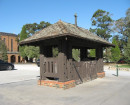FORMER TEMPERANCE HALL
ROGER STREET HEXHAM, MOYNE SHIRE
-
Add to tour
You must log in to do that.
-
Share
-
Shortlist place
You must log in to do that.
- Download report




Statement of Significance
What is significant?
The former Temperance Hall, Hexham was constructed in 1876 through public subscriptions for use as a temperance hall, mechanics institute and reading room. The architect for the building is believed to have been Andrew Kerr. It is a small, gabled bluestone building in simple classical form finely detailed with contrasting stone dressings, round arched window mouldings, a circular vent to the pediment, fanlights over the entrances with the words 'Temperance Hall' and the date '1876' inscribed on the front fanlight. The gabled roof is of corrugated iron. At the rear of the building is a bluestone skillion section with a side round arched door with a fanlight. The interior of the hall features a coved ceiling lined with timber boards.
The temperance movement was established in Australia in the 1830s and advocated abstinence from alcohol and reduced hotel trading. Drawing most of its support from evangelical Protestant churches, the movement gained momentum in the 1880s, reinforced by the influence of women, in particular the Women's Christian Temperance Union.
The Hexham hall was used for social gatherings, concerts, lectures, library and other public purposes as well as for meetings of local temperance friendly societies including the Good Templar Lodge no. 190 and the Rechabite Lodge.
How is it significant?
The former Temperance Hall, Hexham is of historical and architectural significance to the State of Victoria.
Why is it significant?
The former Temperance Hall is of historical significance as one of a small number of temperance halls surviving in Victoria. It is of historical significance for its association with the temperance movement which played an important role in the social development of late nineteenth and early twentieth century Victoria. The temperance hall is linked with the strongly Protestant character of the district.
The former Temperance Hall is of architectural significance for its restrained Classical design, which reflects the moral values exhorted by the temperance movement.
-
-
FORMER TEMPERANCE HALL - Plaque Citation
Built in 1876, this is a rare surviving example of a hall constructed for one of the many friendly societies and temperance organisations which played an important role in nineteenth-century Victoria.
FORMER TEMPERANCE HALL - Permit Exemptions
General Exemptions:General exemptions apply to all places and objects included in the Victorian Heritage Register (VHR). General exemptions have been designed to allow everyday activities, maintenance and changes to your property, which don’t harm its cultural heritage significance, to proceed without the need to obtain approvals under the Heritage Act 2017.Places of worship: In some circumstances, you can alter a place of worship to accommodate religious practices without a permit, but you must notify the Executive Director of Heritage Victoria before you start the works or activities at least 20 business days before the works or activities are to commence.Subdivision/consolidation: Permit exemptions exist for some subdivisions and consolidations. If the subdivision or consolidation is in accordance with a planning permit granted under Part 4 of the Planning and Environment Act 1987 and the application for the planning permit was referred to the Executive Director of Heritage Victoria as a determining referral authority, a permit is not required.Specific exemptions may also apply to your registered place or object. If applicable, these are listed below. Specific exemptions are tailored to the conservation and management needs of an individual registered place or object and set out works and activities that are exempt from the requirements of a permit. Specific exemptions prevail if they conflict with general exemptions. Find out more about heritage permit exemptions here.Specific Exemptions:General Conditions: 1. All exempted alterations are to be planned and carried out in a manner which prevents damage to the fabric of the registered place or object. General Conditions: 2. Should it become apparent during further inspection or the carrying out of works that original or previously hidden or inaccessible details of the place or object are revealed which relate to the significance of the place or object, then the exemption covering such works shall cease and Heritage Victoria shall be notified as soon as possible. General Conditions: 3. If there is a conservation policy and plan endorsed by the Executive Director, all works shall be in accordance with it. Note: The existence of a Conservation Management Plan or a Heritage Action Plan endorsed by the Executive Director, Heritage Victoria provides guidance for the management of the heritage values associated with the site. It may not be necessary to obtain a heritage permit for certain works specified in the management plan. General Conditions: 4. Nothing in this determination prevents the Executive Director from amending or rescinding all or any of the permit exemptions. General Conditions: 5. Nothing in this determination exempts owners or their agents from the responsibility to seek relevant planning or building permits from the responsible authorities where applicable. Minor Works : Note: Any Minor Works that in the opinion of the Executive Director will not adversely affect the heritage significance of the place may be exempt from the permit requirements of the Heritage Act. A person proposing to undertake minor works may submit a proposal to the Executive Director. If the Executive Director is satisfied that the proposed works will not adversely affect the heritage values of the site, the applicant may be exempted from the requirement to obtain a heritage permit. If an applicant is uncertain whether a heritage permit is required, it is recommended that the permits co-ordinator be contacted.
Interior:
Painting of previously painted walls and ceilings provided that preparation or painting does not remove evidence of any original paint or other decorative scheme.
Installation, removal or replacement of carpets and/or flexible floor coverings.
Installation, removal or replacement of curtain tracks, rods and blinds.
Installation, removal or replacement of hooks, nails and other devices for the hanging of mirrors, paintings and other wall mounted art or religious works or icons.
Removal or replacement of non-original door and window furniture including, hinges, locks, knobsets and sash lifts.
Installation, removal or replacement of ducted, hydronic or concealed radiant type heating provided that the installation does not damage existing skirtings and architraves and that the central plant is concealed.
Installation, removal or replacement of electrical wiring.
Installation, removal or replacement of electric clocks, public address systems, detectors, alarms, emergency lights, exit signs, luminaires and the like on plaster surfaces.
Installation, removal or replacement of bulk insulation in the roof space.
Installation of new fire hydrant services including sprinklers, fire doors and elements affixed to plaster surfaces.
Landscape:
The process of gardening and maintenance, mowing, hedge clipping, bedding displays, removal of dead plants, disease and weed control, emergency and safety works to care for existing plants and planting themes.
Removal of vegetation that is not significant to maintain fire safety and to conserve significant buildings and structures.
Management of trees in accordance with Australian Standard, Pruning of amenity trees AS4373.
Removal of plants listed as noxious weeds in the Catchment and Land Protection Act 1994.
Installation, removal or replacement of garden watering and drainage systems.
Non-commercial signage, lighting, security fire safety and other safety requirements, provided no structural building occurs.
Resurfacing of existing paths and driveways.
FORMER TEMPERANCE HALL - Permit Exemption Policy
The purpose of the permit exemptions is to allow works that do not impact on the heritage significance of the place to occur without the need for a permit. Alterations which impact on the significance of this structure are subject to permit applications. The principal cultural heritage significance of the former Temperance Hall is as one of a small number of temperance halls surviving in Victoria.
-
-
-
-
-
Former Temperance Hall
 National Trust H2145
National Trust H2145 -
St Andrew's Presbyterian Church
 National Trust
National Trust -
Hexham Hotel
 National Trust
National Trust
-
177 Fenwick Street
 Yarra City
Yarra City -
19 Cambridge Street
 Yarra City
Yarra City -
2 Derby Street
 Yarra City
Yarra City
-
-












